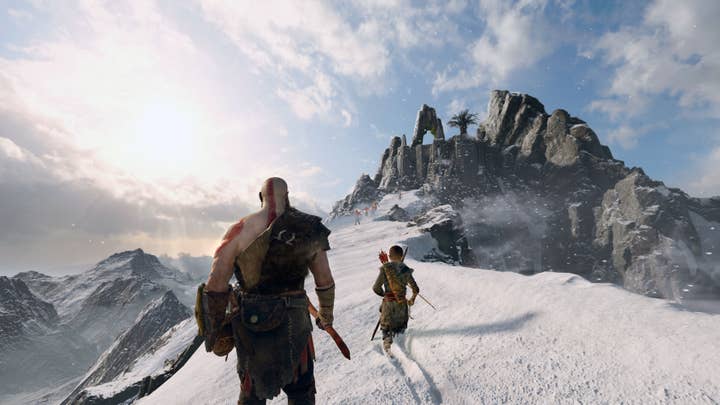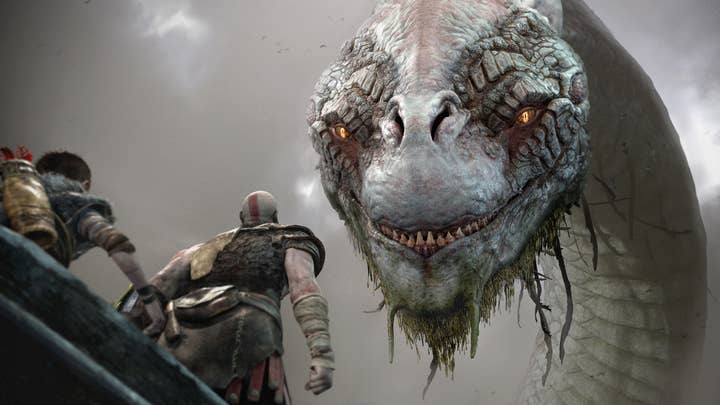God of War: Critical Consensus
Sony Santa Monica's reboot finds the heart beneath Kratos' anger, and does so without sacrificing any of the series' visual splendour
God of War was once the byword for a distinctive brand of action - histrionic in tone, colossal in scale, and with an attention to brutal, bloody detail that verged on the pornographic.
At a time when the narrative content of blockbuster games received less scrutiny, Kratos' endless rage was the driving energy of two of the most electrifying games of the PlayStation 2 era. By the time God of War 3 was released in 2010, however, the sense that Kratos' anger was as empty as it was endless started to take root. When Ascension launched three years later, God of War looked like a franchise in dire need of new ideas - and perhaps a little introspection.
"Fights are infinitely more tense than they ever were in the older games"
The AV Club
With this reboot, that's precisely what Sony Santa Monica Studio has done, electing not to completely redefine Kratos and his rage, but to place both in a more realistic context, where the character is forced to reckon with the legacy of his actions.
As Kotaku notes in its largely glowing review, "much has changed", but those changes are not limited to the treatment of the protagonist.
"The original series was defined by its automatic camera angles, which were carefully hand-placed by the game's designers to always frame the game's action in a specific way. What this meant in practice was that any scene in the game, no matter how intense the action, could be shown from a dramatic, exciting angle, often zoomed far back to show the scale of the object (or the monster or the god) that termite-sized Kratos was running on, climbing up, or slicing his chain-blades into.

"In the new God of War, this signature look is no more: The camera is positioned over Kratos' right shoulder, and you control it (and thus his positioning) with the right stick, like so many other third-person action games. While this does work well to enable a more deliberate, less arcadey combat style, it also saps the series' ability to show off that sort of cinematic spectacle, replacing it with something that looks a lot more like many other triple-A third-person action games."
The AV Club elaborates on the new camera's impact on combat, specifically in the extra difficulty players now face in keeping track of enemies - which the game's designers aid through the use of off-screen indicators.
"It isn't immune to cliche, but does well to avoid becoming too saccharine"
The Telegraph
"This over-the-shoulder sword combat is a pretty unexplored style - strangely enough, the closest comparison is last year's Hellblade: Senua's Sacrifice, also a game based on Norse myth - and it takes a few hours of getting used to, but once you're settled in, those indicators and the accompanying warnings Atreus shouts are enough to keep you informed in all but the most hectic scrambles.
"Even in those cases, getting hit from off-screen doesn't usually feel unfair or irritating. Maintaining control and being aware of your surroundings is half the battle. That new demand, plus your vantage point on the action and Kratos' quickly diminished health, make fights infinitely more tense than they ever were in the older games."
The "Atreus" mentioned in The AV Club's excellent review is another important difference in God of War: this is Kratos' son, his constant companion throughout the game, and the main reason why he spends so much time looking anguished, ruminating on his bestial past.
Atreus also adds a new dimension to the combat, which US Gamer believes has traded a certain amount of the series' trademark fluidity for a greater emphasis on tactics - much to the benefit of the game overall.

"You're also in control of Atreus with the press of the Square button. (Yep, press Square to Son.) Atreus begins helping Kratos using only his trusty bow and arrow. This can deal minimal damage, but it also stuns enemies a bit and can draw the focus away from Kratos... So while you're axing enemies to death, you can also hit fliers or delay enemies with the kid's arrows. And using bare-handed attacks and Atreus' bow together is more likely to put enemies in a stunned state, allowing you to use God of War's executions."
However, while anyone playing God of War will spend a lot of time in combat, all of these apparently surface-level changes serve the larger purpose of telling Kratos' story. In a five-star review, The Telegraph praises the relationship between father and son for being "superbly pitched", and largely free of heavy-handed moments.
"It is a game that, until recently, would have been impossible"
The Guardian
"Both of them initially struggle to come to terms with their relationship, Kratos struggling with his inner-demons, Atreus with his father's hitherto absence and fury. It isn't immune to cliche, but does well to avoid becoming too saccharine. Kratos is a coiled spring and harsh taskmaster that is quick to admonish, with a temper that isn't always easy to like. But that only manages to make the tender moments more effective. God of War is open about Kratos' descent into thuggery in previous games, but you buy into his desire for Atreus to avoid repeating his folly without absolving him.
"It is not an easy balancing act, particularly for a video game in which you are using an axe to snap the jaw of an ogre, but the central relationship carries the game admirably."
This is greatly helped by another change that, in most other games, would be purely mechanical. Where the previous God of War games were linear, the reboot leans towards a large map that invites the term "open world". However, while the map does serve the typical agenda of giving players extra content to chew on, Waypoint is more impressed with the "unexpected moments of quiet and silence" it affords.

"God of War fills these moments with meaningful, character-building banter between a forcibly bonded father and son. Atreus teases Kratos' inability to tell a story, Kratos asks Atreus what he misses about his mother. Conversations in previous God of War games have tended to be long preambles before two beasts fight one another, but here, it's a chance for introspection and reflection, even if it means Atreus is prying it out of Kratos. These tiny details raise the emotional stakes of fights, and the narrative beats that follow."
One aspect of God of War that hasn't changed is the the level of technical excellence on display, with many of the reviews contributing to its 94 Metacritic average calling it the best looking console game in history. But even here, Sony Santa Monica has found a way to let that visual style feed back into its larger narrative ambitions.
"The game is one continuous shot, with no interruptions," The Guardian marvels in its five-star review. "Irritating necessities such as loading screens are hidden so effectively that you barely realise they are there. This cinematic commitment to Kratos' point of view enhances the story's efforts to humanise him. You walk in his boots, flowing between combat, story scenes and exploration without interruption.
"There are abundant moments of outstanding beauty: canoeing beneath the rusting legs of an ancient statue of Thor and on to a lake; traversing the bodies of fallen giants; entering a temple to find cavernous, treasure-packed chambers, resplendent works of virtual architecture. It is among the most visually impressive games made - so much so that rendering it makes the PlayStation 4 sound as if it's about to expire.
"It is rare to play a game so accomplished in everything it sets out to do. God of War is a standard-setter both technologically and narratively. It is a game that, until recently, would have been impossible."
